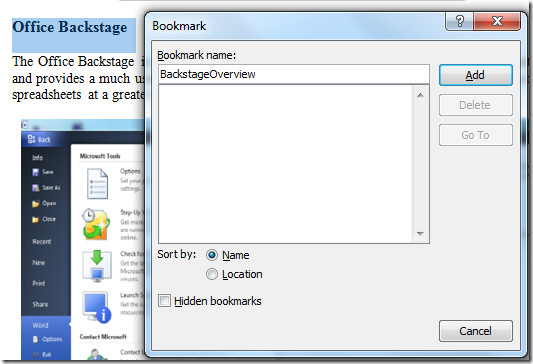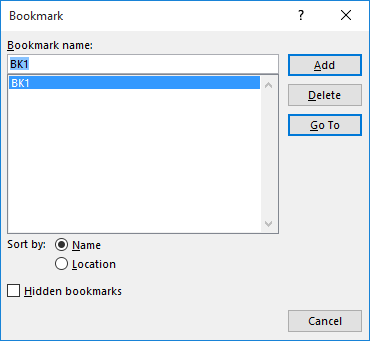
- #How to create a bookmark in word 2010 how to
- #How to create a bookmark in word 2010 update
- #How to create a bookmark in word 2010 code
To mark all occurrences of the text within the whole document, then you can select the “Mark All” button, instead. If you want to format the page numbering used for a normal index entry, you can check either or both the “Bold” or “Italic” checkboxes in the “Page number format” section.Īt that point, if you simply want to mark only the current index entry, then you can click the “Mark” button. If you want to make a straightforward index entry, then select the “Current page” option in the “Options” section.

If you want to create a cross-reference, then choose that option and enter the text for the cross-referenced index entry after the word “See” in the adjacent text box.
#How to create a bookmark in word 2010 how to
In the “Options” section, you can choose how to present the index entry. If you want to create a third level entry, then you can enter the subentry into the “Subentry:” text box, followed by a colon symbol, followed by the third-level index entry. In the “Subentry:” text box, you can enter an index entry that falls under the more general index entry above, if needed. If you did not select any text, then you may simply type the entry that you want to make into the “Main entry:” text box. If you selected text from your document, it will appear in the “Main entry:” text box. That will open the “Mark Index Entry” dialog box. Then click the “Mark Entry” button in the “Index” group on the “References” tab in the Ribbon. If you want to include a word or phrase, you can start by selecting the word or phrase that you want to include from the text within your document. In the “References” tab, you use the buttons that are available in the “Index” group to mark your text and create the index.įirst, let’s examine the process of marking text or a range of pages for inclusion in the index. Start by clicking the “References” tab in the Ribbon. You can create multiple subentries and even cross-references entries in your index. Then you compile the index in much the same way that you created the table of contents. First, you mark the subjects or topics that you want to reference in the index. This process is similar in nature to creating a table of contents.
#How to create a bookmark in word 2010 code
You could add this \* charformat part into the toggled field code instead, but there’s more chance of making a mistake.In Microsoft Word, you can create an index of entries or topics for formal papers or long documents.

Here’s what you do in Word 2003 (Word 20 should be similar once you get to the Field window): So today I’d had enough! I found out how to fix it, and I’m hoping this fix will hold for all future field code updates (it’s held the few times I’ve updated the doc today, so here’s hoping…)

#How to create a bookmark in word 2010 update
If I manually format the incorrect one, when I update the fields using F9, it goes back to 14 pt bold all caps. I’ve checked and double-checked the Edit Field and Toggle Field Code options to see if there’s anything different between the two.

I’ve put two of these suckers into the same sentence-one will go in OK and take the formatting of the surrounding sentence the other displays in the formatting of the appendix heading (all caps and 14 pt bold!). Most times the cross-reference goes in as it should-formatted the same as the surrounding text.īut on the odd occasion and for no apparent reason, the cross-reference decides to display the formatting of the original appendix heading. When we need to cross-reference the appendix in the main text, we select the name from the list of bookmarks and insert it. ‘Appendix B’) and add it as a bookmark (‘AppendixB’). We’ve been using Word’s Bookmark feature to select the first part of the appendix title (e.g. Lately I’ve been working with a colleague on some long documents with lots of Appendices etc.


 0 kommentar(er)
0 kommentar(er)
